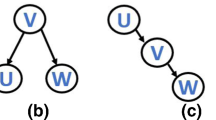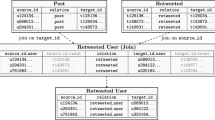Abstract
The information diffusion on social media shows no signs of stopping, and for many marketers, having influencers spread information has become a common advertising method. However, the use of social media has diversified, and the intentions behind following other users can vary greatly. Correspondingly, there are several patterns of communication on social media, and based on the density and symmetry of these communications, it is believed that one can infer the intentions of the users who follow others. In this study, we consider retweets, replies, and mentions, three types of communication in the context of follower relationships on Twitter, as a multi-layer graph. We propose multi-layer motifs by categorizing the edges, and we associate motif patterns with follower intentions to infer users’ follow intents. Through experiments using real data, we confirm that our proposed multi-layer motifs can extract link patterns leading to follow intentions that would not be detectable using traditional single-layer motifs.
Access this chapter
Tax calculation will be finalised at checkout
Purchases are for personal use only
Similar content being viewed by others
References
Ahmed, N.K., Neville, J., Rossi, R.A., Duffield, N.: Efficient graphlet counting for large networks. In: 2015 IEEE International Conference on Data Mining, pp. 1–10 (2015)
Braha, D., Bar-Yam, Y.: Time-dependent complex networks: dynamic centrality, dynamic motifs, and cycles of social interactions. In: Gross, T., Sayama, H. (eds.) Adaptive Networks. Understanding Complex Systems. Springer, Berlin, Heidelberg (2009). https://doi.org/10.1007/978-3-642-01284-6_3
De Domenico, M., Lima, A., Mougel, P., Musolesi, M.: The anatomy of a scientific rumor. Sci. Rep. 3, 2980 (2013)
Kato, S., Koide, A., Fushimi, T., Saito, K., Motoda, H.: Network analysis of three twitter functions: favorite, follow and mention. In: Richards, D., Kang, B.H. (eds.) PKAW 2012. LNCS (LNAI), vol. 7457, pp. 298–312. Springer, Heidelberg (2012). https://doi.org/10.1007/978-3-642-32541-0_26
McDonnell, M.D., Yaveroglu, O.N., Schmerl, B.A., Iannella, N., Ward, L.M.: Motif-role-fingerprints: the building-blocks of motifs, clustering-coefficients and transitivities in directed networks. PLOS ONE 9(12), 1–25 (2014). https://doi.org/10.1371/journal.pone.0114503
Milo, R., Shen-Orr, S., Itzkovitz, S., Kashtan, N., Chklovskii, D., Alon, U.: Network motifs: simple building blocks of complex networks. Science (New York, N.Y.) 298(5594), 824–827 (2002)
Ohnishi, T., Takayasu, H., Takayasu, M.: Network motifs in an inter-firm network. J. Econ. Interac. Coord. 5(2), 171–180 (2010)
Pinar, A., Seshadhri, C., Vishal, V.: ESCAPE: efficiently counting all 5-vertex subgraphs. In: Proceedings of the 26th International Conference on World Wide Web, pp. 1431–1440. WWW 2017, Republic and Canton of Geneva, CHE (2017). https://doi.org/10.1145/3038912.3052597
Pržulj, N.: Biological network comparison using graphlet degree distribution. Bioinformatics 23(2), 177–183 (2007). https://doi.org/10.1093/bioinformatics/btl301
Takemura, H., Tanaka, A., Tajima, K.: Classification of twitter follow links based on the followers’ intention. In: Proceedings of the 30th Annual ACM Symposium on Applied Computing, pp. 1174–1180. SAC 2015, Association for Computing Machinery, New York, NY, USA (2015). https://doi.org/10.1145/2695664.2695940
Tanaka, A., Takemura, H., Tajima, K.: Why you follow: a classification scheme for twitter follow links. In: Proceedings of the 25th ACM Conference on Hypertext and Social Media. pp. 324–326. HT 2014, Association for Computing Machinery, New York, NY, USA (2014). https://doi.org/10.1145/2631775.2631790
Acknowledgments
This material is based upon work supported by JSPS Grant-in-Aid for Scientific Research (C) (JP22K12279).
Author information
Authors and Affiliations
Corresponding author
Editor information
Editors and Affiliations
Rights and permissions
Copyright information
© 2024 The Author(s), under exclusive license to Springer Nature Switzerland AG
About this paper
Cite this paper
Fushimi, T., Miyazaki, T. (2024). Classification of Following Intentions Using Multi-layer Motif Analysis of Communication Density and Symmetry Among Users. In: Cherifi, H., Rocha, L.M., Cherifi, C., Donduran, M. (eds) Complex Networks & Their Applications XII. COMPLEX NETWORKS 2023. Studies in Computational Intelligence, vol 1143. Springer, Cham. https://doi.org/10.1007/978-3-031-53472-0_4
Download citation
DOI: https://doi.org/10.1007/978-3-031-53472-0_4
Published:
Publisher Name: Springer, Cham
Print ISBN: 978-3-031-53471-3
Online ISBN: 978-3-031-53472-0
eBook Packages: EngineeringEngineering (R0)




